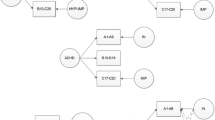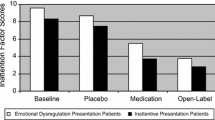Abstract
The objective of the study was to examine the factor structure of attention-deficit/hyperactivity disorder (ADHD) symptoms in a representative population survey of adults and the association of these factors with health outcomes. Hierarchical and correlated factor analysis models were compared, and regression analyses with these models were used to determine the associations with psychological distress and substance use problems. A total of 1449 adults 18–65 years of age participated in a cross-sectional survey over the phone. ADHD symptom data came from an ADHD screener (10 items), and health outcomes were assessed using a questionnaire measuring psychological distress and two measures of substance use problems. The hierarchical general factor models with specific factors best represented the structure of ADHD in this representative population survey. The general factor and residual inattention factor were significantly associated with psychological distress, and the general factor was associated with substance use problems. From the correlated factor models, the inattention factor was associated with psychological distress and the hyperactivity factor was related to substance use problems. The hierarchical and correlated factor models explained similar levels of variance in outcomes. The results replicate previous studies indicating that a model of ADHD symptoms with a unitary dimension and separable dimensions of residual inattention and hyperactivity/impulsivity demonstrates a better fit than correlated factor models. The ADHD general factor was consistently significantly related to outcomes.


Similar content being viewed by others
Notes
In these bifactor models, it is important to recognize that the specific factors represent residual covariation among items, which is the relationships between items that remain with covariation due to the general factor removed. Therefore, the specific factor for the inattention items, for example, does not necessarily represent the construct of inattention itself or an inattention subscale; instead, it represents the relationships between these items that remains while accounting for a broader ADHD construct.
Consistent results were obtained when the items were treated as categorical, and the CFA models were estimated using a robust weighted least-squares method (i.e., the WLSMV estimator in Mplus).
Due to technical estimation issues, it was not possible to regress the binary problem score outcome on all four factors from the bifactor model with three specific factors simultaneously. Therefore, this outcome was first regressed on the general factor and the residual inattention and hyperactivity factors in one model, and then a separate model was used to regress the binary outcome on the general factor and the residual inattention and impulsivity factors.
References
Adams CD, Kelley ML, McCarthy M (1997) The adolescent behavior checklist: development and initial psychometric properties of a self-report measure for adolescents with ADHD. J Clin Child Psychol 26:77–86
American Psychiatric Association (2000) Diagnostic and statistical manual of mental disorders (4th ed., text rev.). Author, Washington
American Psychiatric Association (2013) Diagnostic and statistical manual of mental disorders, 5th edn. American Psychiatric Publishing, Arlington
Babor TF, Biddle-Higgins JC, Saunders JB, Monteiro MG (2001) AUDIT: the alcohol use disorders identification test: guidelines for use in primary health care. World Health Organization, Geneva
Baker L, Prevatt F, Proctor B (2012) Drug and alcohol use in college students with and without ADHD. J Atten Disord 16:255–263. doi:10.1177/1087054711416314
Barkley RA (2006) Attention deficit hyperactivity disorder: a handbook for diagnosis and treatment, 3rd edn. Guilford, New York
Biederman J, Faraone SV, Spencer TJ, Mick E, Monuteaux MC, Aleardi M (2006) Functional impairments in adults with self-reports of diagnosed ADHD: a controlled study of 1001 adults in the community. J Clin Psychiatry 67:524–540
Burke JD, Loeber R, White HR, Stouthamer-Loeber M, Pardini DA (2007) Inattention as a key predictor of tobacco use in adolescence. J Abnorm Psychol 116:249–259. doi:10.1037/0021-843X.116.2.249
Campbell A, Walker J, Farrell G (2003) Confirmatory factor analysis of the GHQ-12: can I see that again? Aust NZ J Psychiatry 37:475–483. doi:10.1046/j.1440-1614.2003.01208.x
Conners CK (2008) Conners 3rd edition: Manual. Multi-Health Systems Inc., Toronto
Daeppen JB, Yersin B, Landry U, Pécoud A, Decrey H (2000) Reliability and validity of the alcohol use disorders identification test (AUDIT) imbedded within a general health risk screening questionnaire: results of a survey in 332 primary care patients. Alcohol Clin Exp Res 24:659–665. doi:10.1111/j.1530-0277.2000.tb02037.x
Donath S (2001) The validity of the 12-item General Health Questionnaire in Australia: a comparison between three scoring methods. Australas N Z J Psychiatry 35:231–235. doi:10.1046/j.1440-1614.2001.00869.x
Dumenci L, McConaughy SH, Achenbach TM (2004) A hierarchical three-factor model of inattention-hyperactivity-impulsivity derived from the attention problems syndrome of the teacher’s report form. School Psychol Rev 33:287–301
Gibbins C, Toplak ME, Flora DB, Weiss MD, Tannock R (2012) Evidence for a general factor model of ADHD in adults. J Atten Disord 16:635–644. doi:10.1177/1087054711416310
Goldberg D, Williams P (1988) A user’s guide to the general health questionnaire. NFER-Nelson, Windsor
Gomez R (2014) ADHD bifactor model based on parent and teacher ratings of Malaysian children. Asian J Psychiatry 8:47–51. doi:10.1016/j.ajp.2013.10.009
Groenman AP, Oosterlaan J, Rommelse N, Franke B, Roeyers H, Oades RD, Sergeant JA, Faraone SV et al (2013) Substance use disorders in adolescents with attention deficit hyperactivity disorder: a 4-year follow-up study. Addiction 108:1503–1511. doi:10.1111/add.12188
Gudjonsson GH, Sigurdsson JF, Eyjolfsdottir GA, Smari J, Young S (2009) The relationship between satisfaction with life, ADHD symptoms, and associated problems among university students. J Atten Disord 12:507–515. doi:10.1177/1087054708323018
Hardy GE, Shapiro DA, Havnes CE, Rick JE (1999) Validation of the general health questionnaire-12: using a sample of employees from England’s health care services. Psychol Assess 11:159–165. doi:10.1037/1040-3590.11.2.159
Humeniuk R, Ali R, Babor TF, Farrell M, Formigoni ML, Jittiwutikarn J, de Lacerda RB, Simon S et al (2008) Validation of the alcohol, smoking and substance involvement screening test (ASSIST). Addiction 103:1039–1047. doi:10.1111/j.1360-0443.2007.02114.x
Huntley Z, Young S (2014) Alcohol and substance use history among ADHD adults: the relationship with persistent and remitting symptoms, personality, employment, and history of service use. J Atten Disord 18:82–90. doi:10.1177/1087054712446171
Ialomiteanu A, Hamilton HA, Adlaf EM, Mann RE (2014) CAMH monitor eReport: substance use, mental health and well being among Ontario adults, 1977–2013. (CAMH Research Document Series No. 40). Centre for Addiction and Mental Health, Toronto
Katusic SK, Barbaresi WJ, Colligan RC, Weaver AL, Leibson CL, Jacobsen SJ (2005) Psychostimulant treatment and risk for substance abuse among young adults with a history of attention-deficit/hyperactivity disorder: a population-based, birth cohort study. J Child Adolesc Psychopharmacol 15:764–776. doi:10.1089/cap.2005.15.764
Kessler RC, Adler L, Ames M, Demler O, Faraone SV, Hiripi E, Howes M, Walters EE et al (2005) The world health organization adult ADHD self-report scale (ASRS): a short screening scale for use in the general population. Psychol Med 35:245–256
Kessler RC, Adler L, Barkley R, Biederman J, Conners CK, Demler O, Faraone SV, Zaslavsky AM et al (2006) The prevalence and correlates of adults ADHD in the United States: results from the national comorbidity survey replication. Am J Psychiatry 163:716–723. doi:10.1176/appi.ajp.163.4.716
Kousha M, Shahrivar Z, Alaghband-Rad J (2012) Substance use disorder and ADHD: is ADHD a particularly “specific” risk factor? J Atten Disord 16:325–332. doi:10.1177/1087054710387265
Lahey BB, Rathouz PJ, Van Hulle C, Urbano RC, Kreuger RF, Applegate B, Garriock HA, Waldman ID et al (2008) Testing structural models of DSM-IV symptoms of common forms of child and adolescent psychopathology. J Abnorm Child Psych 36:187–206. doi:10.1007/s10802-007-9169-5
Martel MM, Von Eye A, Nigg JT (2010) Revisiting the latent structure of ADHD: is there a ‘g’ factor? J Child Psychol Psychiatry 51:905–914. doi:10.1111/j.1469-7610.2010.02232.x
Meinzer MC, Lewinsohn PM, Pettit JW, Seeley JR, Gau JM, Chronis-Tuscano A, Waxmonsky JG (2013) Attention-deficit/hyperactivity disorder in adolescence predicts onset of major depressive disorder through early adulthood. Depress Anxiety 30:546–553. doi:10.1002/da.22082
Moffitt TE, Arseneault L, Belsky D, Dickson N, Hancox RJ, Harrington H, Houts R, Caspi A et al (2011) A gradient of childhood self-control predicts health, wealth, and public safety. Proc Natl Acad Sci USA 108:2693–2698. doi:10.1073/pnas.1010076108
Morin AJ, Tran A, Caci H (2013) Factorial validity of the ADHD adult symptom rating scale in a French community sample: results from the ChiP-ARDS study. J Atten Disord. doi:10.1177/1087054713488825
Muthén LK, Muthén BO (2010) Mplus user’s guide, 6th edn. Muthén and Muthén, Los Angeles
Navaro P, Ascaso C, Garcia-Esteve L, Aguado J, Torres A, Martin-Santos R (2007) Postnatal psychiatric morbidity: a validation study of the GHQ-12 and the EPDS as screening tools. Gen Hosp Psychiatry 29:1–7. doi:10.1016/j.genhosppsych.2006.10.004
Ng JW, Kwan R, Cheok CC (2014) Clinical and functional outcomes in young adult males with ADHD. J Attn Disord (published online)
Nigg JT, Casey BJ (2005) An integrative theory of attention-deficit/hyperactivity disorder based on the cognitive and affective neurosciences. Dev Psychopathol 17:785–806. doi:10.1017/S0954579405050376
Normand S, Flora DB, Toplak ME, Tannock R (2012) Evidence for a general ADHD factor from a longitudinal general school population study. J Abnorm Child Psychol 40:555–567. doi:10.1007/s10802-011-9584-5
Rhemtulla M, Brosseau-Liard P, Savalei V (2012) When can categorical variables be treated as continuous? A comparison of robust continuous and categorical SEM estimation methods in non-ideal conditions. Psychol Methods 17:354–373. doi:10.1037/a0029315
Sagvolden T, Johansen EB, Aase H, Russell VA (2005) A dynamic developmental theory of attention-deficit/hyperactivity disorder (ADHD) predominantly hyperactive/impulsive and combined subtypes. Behav Brain Sci 28:397–468. doi:10.1017/S0140525X05000075
Saunders JB, Aasland OG, Babor TF, de la Fuente JR, Grant M (1993) Development of the alcohol use disorders screening test (AUDIT). WHO collaborative project on early detection of persons with harmful alcohol consumption. Addiction 88:791–804
Sonuga-Barke EJS (2005) Causal models of attention-deficit/hyperactivity disorder: from common simple deficits to multiple developmental pathways. Biol Psychiatry 57:121–1238. doi:10.1016/j.biopsych.2004.09.008
Sonuga-Barke EJS, Sergeant JA, Nigg J, Willcutt E (2008) Executive dysfunction and delay aversion in attention deficit hyperactivity disorder: nosologic and diagnostic implications. Child Adolesc Psychiatr Clin N Am 17:367–384. doi:10.1016/j.chc.2007.11.008
Spencer TJ, Faraone SV, Tarko L, McDermott K, Biederman J (2014) Attention-deficit/hyperactivity disorder and adverse health outcomes in adults. J Nerv Ment Dis 202:725–731. doi:10.1097/NMD.0000000000000191
Strickland J, Keller J, Lavigne JV, Gouze K, Hopkins J, LeBailly S (2011) The structure of psychopathology in a community sample of preschoolers. J Abnorm Child Psychol 39:601–610. doi:10.1007/s10802-011-9487-5
Toplak ME, Pitch A, Flora DB, Iwenofu L, Ghelani K, Jain U, Tannock R (2009) The unity and diversity of inattention and hyperactivity/impulsivity in ADHD: evidence for a general factor with separable dimensions. J Abnorm Child Psychol 37:1137–1150. doi:10.1007/s10802-009-9336-y
Toplak ME, Sorge GB, Flora DB, Chen W, Banaschewski T, Buitelaar J, Ebstein R, Faraone SV et al (2012) The hierarchical factor model of ADHD: invariant across age and national groupings? J Child Psychol Psychiatry 53:292–303. doi:10.1111/j.1469-7610.2011.02500.x
WHO Assist Working Group (2002) The alcohol, smoking and substance involvement screening test (ASSIST): development, reliability and feasibility. Addiction 97:1183–1194
Wilens TE (2011) A sobering fact: ADHD leads to substance abuse. J Am Acad Child Adolesc Psychiatry 50:6–8. doi:10.1016/j.jaac.2010.10.002
Wilens TE, Martelon M, Joshi G, Bateman C, Fried R, Petty C, Biederman J (2011) Does ADHD predict substance-use disorders? A 10-year follow-up study of young adults with ADHD. J Am Acad Child Adolesc Psychiatry 50:543–553. doi:10.1016/j.jaac.2011.01.021
Author information
Authors and Affiliations
Corresponding author
Rights and permissions
About this article
Cite this article
Sorge, G.B., Flora, D.B., van der Maas, M. et al. Using factor analytic models to examine the association between attention-deficit/hyperactivity disorder symptoms and health-related outcomes in a representative population survey. ADHD Atten Def Hyp Disord 7, 225–235 (2015). https://doi.org/10.1007/s12402-015-0167-0
Received:
Accepted:
Published:
Issue Date:
DOI: https://doi.org/10.1007/s12402-015-0167-0




